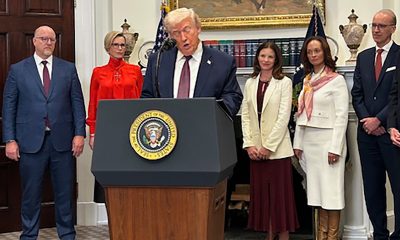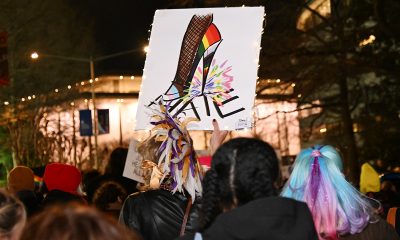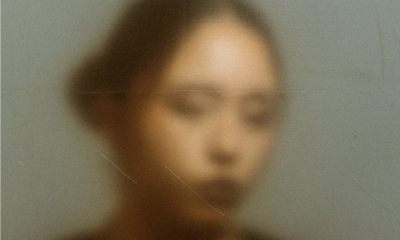a&e features
Pride, activist groups, the gay press and more take form in wake of Stonewall riots
Bumps and hurdles loomed in most areas as movement came of age in ‘70s and beyond
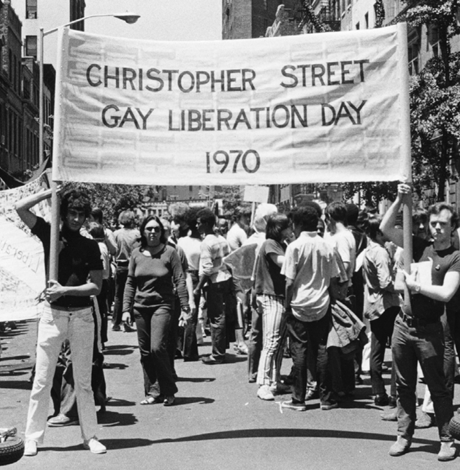
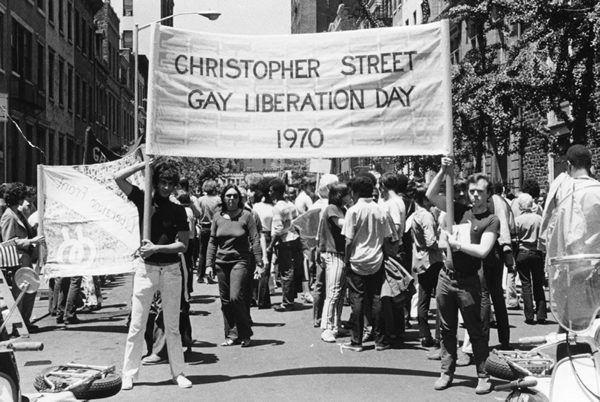
The most impactful legacy of Stonewall isn’t what happened those few nights, but what grew out of it — annual Pride celebrations, of course, but also the gay press, a proliferation of rights groups, de-classification of homosexuality as mental illness, disco, sexual lib, AIDS and more. Whole books have been written on each of these topics, for anyone interested in further study.
THE BIRTH OF PRIDE
Some of the people who rioted starting on June 28, 1969, once things settled, started to organize and a group called the Stonewall Veterans Association, which is still in existence, formed.
In November 1969, Craig Rodwell (1940-1993), owner of the Oscar Wilde Memorial Bookshop (the country’s first gay bookstore), along with his partner Fred Sargeant, Ellen Broidy and Linda Rhodes, proposed a New York City march to commemorate the riots. He introduced a resolution at the Eastern Regional Conference of Homophile Organization (ERCHO) in Philadelphia.
“We propose that a demonstration be held annually on the last Saturday in June in New York City to commemorate the 1969 spontaneous demonstrations on Christopher Street and this demonstration be called Christopher Street Liberation Day,” the resolution said. “No dress or age regulations shall be made for this demonstration.”
The concept of Pride being held in other cities simultaneously was ingrained in the concept from the outset.
“We also propose that we contact homophile organizations throughout the country and suggest that they hold parallel demonstrations on that day. We propose a nationwide show of support,” the resolution stated.
Christopher Street Liberation Day was held June 28, 1970, the first gay Pride march in the U.S. It covered 51 blocks to Central Park with a parade permit reluctantly delivered just two hours before the scheduled start time. Marches were simultaneously held in Los Angeles and Chicago. In 1971, it had spread to Boston, Dallas, Milwaukee and three European cities as well. Pride in Washington started in 1975.
Since 1984, the parade and related events in New York have been produced and organized by Heritage of Pride, a volunteer, non-partisan LGBT group.
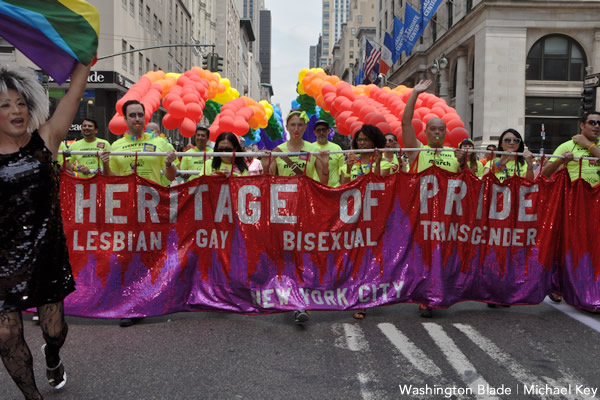
THE GAY PRESS
The gay press didn’t begin with Stonewall. The earliest known publication had an inauspicious start. In 1947, an underworked secretary trying to look busy, typed, stapled and distributed 12 copies of Vice Versa, which she dubbed “America’s gayest magazine.” Since then, thousands have followed in her steps producing about 2,600 — at their height — publications ranging from weekly newspapers to more radical tabloids to glossy monthly magazines.
Seminal pre-Stonewall publications included Ladder, Vector and the Los Angeles Advocate.
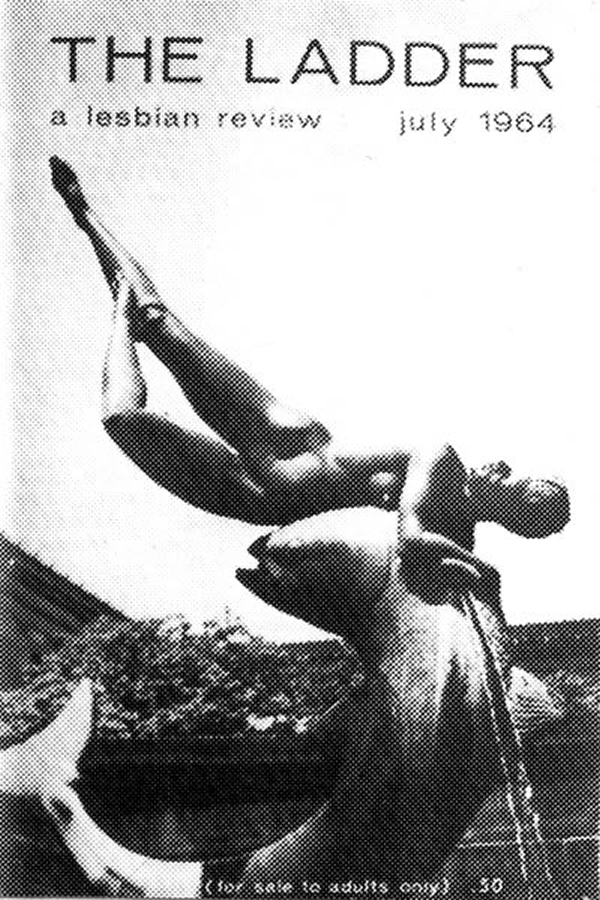
The number of these publications exploded after Stonewall. It was seen as necessary as even the most liberal alternative press of the day — in New York, The Village Voice, refused to print the word gay. “Throughout the ‘70s, people who depended solely on mainstream media for news would hardly have been aware of the gay rights movement,” writes author/historian Eric Marcus in his 2002 book “Making Gay History.” “With a few notable exceptions, the television networks, daily newspapers and newsmagazines gave little coverage to gay issues.”
“After the apocalyptic Stonewall impulse, the press erupted in so many directions that it is impossible to document when each publication was founded, how long it existed or who edited it,” writes Rodger Streitmatter, author of “Unspeakable: the Rise of the Gay and Lesbian Press in America.”
“Our Own Voices: A Directory of Lesbian and Gay Periodicals” listed 150 publications by 1972, Streitmatter writes.
One of the most influential was called simply GAY, started in December 1969 by gay press veterans (and partners) Jack Nichols and Lige Clarke, who’d covered Stonewall. It soon became, according to Streitmatter, the “newspaper of record for gay America.”
Veteran activist Lilli Vincenz, who wrote a lesbian column for GAY, is quoted in “Unspeakable” as having said, “It was the newspaper of the day. If you were gay and you wanted to find out what was going on in the world, you turned to GAY.”
It sold 20,000 copies of its first issue (at 40 cents per copy) and reached a monthly circulation of 25,000 by its second issue, figures that took the Advocate two years to build. Within six weeks, two other New York-based newspapers were launched — Come Out! and Gay Power. GAY continued until Clarke was murdered in 1975.
Streitmatter writes later in the book that the publications “that survived the aftershocks of Stonewall were those with a combination of calm voices and stable finances,” citing GAY in New York and The Advocate in Los Angeles as leaders.
But two months before GAY was launched, in October 1969, Vincenz and a small group of men and women met in the basement of a Connecticut Avenue building to work on the first issue of the Gay Blade. The monthly, mimeographed one-sheet issued by a volunteer staff contained three columns of news, community notices and a small advertisement for someone who wanted to sell a car, writes author Edward Alwood in his 1996 book “Straight News: Gays, Lesbians and the News Media.”
“By distributing copies at the city’s gay and lesbian bars, they quickly established the Blade as a source of valuable information that was not available from any other source,” Alwood writes.
Editor Nancy Tucker told Alwood they printed “things that we thought were important to the mental health and social welfare of other people like us,” Alwood quotes her as having said. “Periodically we ran warnings of blackmailers who hung around Dupont Circle or the gay bars. We wrote about rough cops. There were plenty of military and government workers who were undergoing some type of security investigation and all of those people needed to know about their rights. These were a heavy orientation for us.”
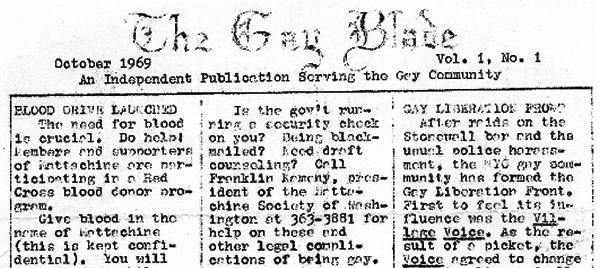
It was the first of a new generation of gay papers that included Gay Community News in Boston, NewsWest in Los Angeles, Gay News in Pittsburgh and GayLife in Chicago, Alwood writes.
“Unlike the early homophile press, which stressed identity and cooperation, this second generation concentrated almost solely on political change and resistance,” Alwood writes.
The Gay Blade was rechristened the Washington Blade in 1980 and went to weekly publication in 1983. It’s the oldest continually operating LGBT newspaper in the country. It celebrates its 50th anniversary in October.
REGIONAL GAY RIGHTS GROUPS
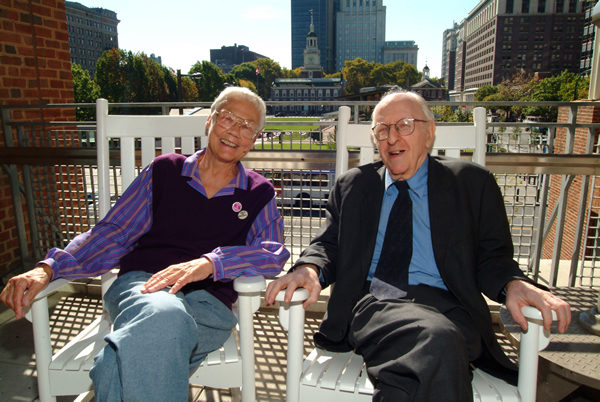
Although groups like the Mattachine Society and Daughters of Bilitis had been around since the ‘50s, things became more emboldened after Stonewall. The Gay Liberation Front was the first organization to use gay in its name. Previously, all “homophile” (as they were known) groups purposefully did not.
Legendary early activists Barbara Gittings and Kay Lahusen were vacationing on Fire Island when they heard about Stonewall. Upon returning to the city in September, they began attending meetings of the Gay Liberation Front and encountered a much different group of people and ethos.
“They were huge meetings, it was the best theater in town,” Lahusen is quoted as having said in “Making Gay History.” “This was the heyday of radical chic … and here I was this plain Jane dinosaur from the old gay movement.”
Gittings said there was zero acknowledgement of the pre-Stonewall efforts.
“Suddenly here were all these people with absolutely no track record in the movement who were telling us, in effect, not only what we should do but what we should think,” she’s quoted as having said in “Making Gay History.” “The arrogance of it was really what upset me.”
Gittings said she and Frank Kameny were even asked at one Philadelphia meeting who they were and what they were doing there.
“For once, I think even Frank was dumbfounded,” Gittings is quoted as having said. “As if we owed them an explanation.”
Gittings said right after Stonewall, the Gay Liberation Front and the Mattachine Society, which some perceived as having been slow to respond to the riots, were the only two active groups.
“Mattacine was so stuffy and its day was over,” Lahusen said in “Making Gay History.” “These organizations seem to have a built-in life expectancy.”
“Mattachine wasn’t up to managing the lively response to the Stonewall riots and GLF came in to fill the void,” Gittings told author Marcus.
The Gay Liberation Front (a name used by multiple groups over the years), however, disbanded after just four months when members were unable to agree on operating procedure. In December 1969, some people who had attended Front meetings but left frustrated formed Gay Activists Alliance (GAA), an “orderly” group to be focused entirely on gay issues. A D.C. chapter had formed by 1971. It became the Gay & Lesbian Activist Alliance in the ‘80s, and continues to this day.
Many of the main groups with major name recognition today started later. The National Gay Task Force (now the National LGBTQ Task Force) started in 1973. Two groups merged to form the largest, Human Rights Campaign, in the early ‘80s.
Many of the state groups came much later, uniting around the marriage issue. The California Alliance for Pride and Equality was founded in 1999 and only became Equality California in 2003. The now-dissolved Empire State Pride Agenda was founded in 1990 through a merger of two earlier groups. By 2005, it was the largest state lobbying group.
AIDS
In a roundabout way, Stonewall, in time, also brought attention to the disparate health care needs of LGBT people. That’s the contention of Perry N. Halkitis, dean of Rutgers School of Public Health and author of the new book “Out in Time: From Stonewall to Queer; How Gay Men Came of Age Across the Generations.”
“The riots allowed gay people to say ‘we exist’ and create a demand for health equity,” Halkitis said in a recent interview with tapinto.net. “The civil disobedience of Stonewall served as a catalyst to the activism of the AIDS era, which in turn has contributed to the foundations of how public health today emphasizes social justice and health equity.”
Although initially about wholly separate issues, Stonewall started a movement that was eventually “catapulted” 13 years later when HIV hit, he says.
“As the riots framed the basis for the recognition of gay people as viable members of the population, the AIDS crisis of the 1980s and ’90s created the circumstances by which they would come to demand that the government and society attend to their well-being,” Halkitis said in the tapinto.net interview. “Before then, gay people kept silent and were invisible to their doctors, who were unaware they were gay or did not understand the mental health and drug issues they were facing. The AIDS crisis shined a light on the fact that there was this population that needed specific health services beyond what was given to the general population.”
Dr. Demetre Daskalakis, deputy commissioner for the Division of Disease Control of the New York City Department of Health and Mental Hygiene, said in a New York Times interview last week that the histories of Stonewall and AIDS are inextricably linked and have affected what’s still happening today.
“It’s so critical that you had an uprising, and it became not just folks being downtrodden by their system but actually then fighting back,” Daskalakis told the Times. “I feel that the fighting spirit now is like the ACT UP experience in New York. There was a feeling that it was part of LGBTQ rights to ask for faster, better support and funding to fight HIV. … I think the legacy of activism remains powerful decades later.”
As the number of deaths soared, gay and lesbian people and gay rights organizations redirected their energies, Marcus writes in “Making Gay History.”
“Many thousands of gay people who had never participated in gay rights efforts were motivated to join the fight against AIDS,” he writes. “New organizations joined existing ones to provide care for the sick and dying, conduct AIDS education programs, lobby local and federal governments for increased funding for AIDS research, pressure medical researchers and drug companies to become more aggressive in their search for treatments and a cure and fight discrimination against people with AIDS and those infected with HIV.”
AMERICAN PSYCHIATRIC ASSOCIATION
In 1973, the American Psychiatric Association removed the diagnosis of “homosexuality” from the second edition of its Diagnostic and Statistical Manual.
In the mid-20th century, some homophile activist groups accepted psychiatry’s illness model as an alternative to societal condemnation of homosexuality’s supposed “immorality” and were willing to work with professionals who sought to “treat” or “cure” them, Jack Drescher writes in his 2015 study “Out of DSM: Depathologizing Homosexuality.” Other activists, however, forcefully rejected the pathological model as a major contributor to the stigma and in the wake of the Stonewall riots, brought modern sex research theories to the attention of the APA.
Believing psychiatric theories to be a major contributor to anti-gay social stigma, activists disrupted the 1970 and 1971 annual APA meetings.
Although, Drescher writes, there were rumblings happening within the world of psychiatry that helped the gay cause, “the most significant catalyst for diagnostic change was gay activism.”
Kameny and Gittings spoke on a 1971 APA panel entitled “Gay is Good.” They returned in ’72, joined by Dr. John Fryer, who appeared anonymously as a “homosexual psychiatrist.”

APA’s Nomenclature Committee eventually recommended removing homosexuality when it determined it unique among the supposed mental disorders in that in and of itself, it did not cause distress nor was it associated with generalized impairment in social effectiveness of functioning.
It wasn’t a completely cut-and-dried affair; the psychiatric world continued grappling with the controversial decision for years, Drescher writes in his scholarly article, but it was “the beginning of the end of organized medicine’s official participation in the social stigmatization of homosexuality.”
Many people, both inside and outside the psychology profession, claimed the APA had succumbed to pressure from gay activists and while it was true that many gay men and lesbians had exerted pressure, there were also respected psychiatrists within the organization who worked to affect the change, Marcus writes in “Making Gay History.” One was Dr. Judd Marmor, a Los Angeles psychiatrist.
“We didn’t merely remove homosexuals from the category of illness. We stated that there was no reason why a priori a gay man or woman could not be just as healthy, just as effective, just as law abiding and just as capable of functioning as any heterosexual,” Marmor is quoted as having said in Marcus’s book. “Furthermore, we asserted that laws that discriminated against them in housing or in employment were unjustified. So it was a total statement.”
Shortly thereafter, the American Psychological Association and the American Bar Association came out in support of gays.
“It was an important step that we took,” Marmor said in “Making Gay History.”
DISCO
Disco music, a type of dance music and the subculture around it that emerged in the ‘70s from the U.S. urban nightlife scene, is inextricably linked to post-Stonewall gay life.
Its “four-on-the-floor” beats, syncopated basslines and shimmery instrumentation flourished in venues popular with black, Latinx and gay nightlife lovers mostly in major cities on the East Coast at the dawn of the ‘70s. The most popular disco artists were Donna Summer, Gloria Gaynor, the Bee Gees, Chic, KC and the Sunshine Band, the Village People, Thelma Houston and others. Pop acts like Diana Ross and Michael Jackson, who’d had hits in other genres, jumped on the disco bandwagon with success.
In his essay “In Defense of Disco,” gay writer Richard Dyer writes that disco gave gay men a mainstream musical genre they could embrace.
“All my life, I’ve liked the wrong music,” he writes. “I never liked Elvis and rock ’n roll; I always preferred Rosemary Clooney. And since I became a socialist, I’ve often felt virtually terrorized by the prestige of rock and folk on the left. … Disco is more than just a form of music, although certainly music is at the heart of it. Disco is also kinds of dancing, club, fashion, film — in a word, a certain sensibility.”
Thematically, Dyer (whose essay is included in the 1995 anthology “Out in Culture: Gay, Lesbian and Queer Essays on Popular Culture”), writes that disco has both rhythmic and lyrical appeal to gay men.
“No wonder (Diana) Ross is (was?) so important in gay male scene culture for she both reflects what that culture takes to be an inevitable reality — that relationships don’t last — and at the same time celebrates it, validates it.”
“Our music owes so much to the gay clubs that first nurtured it, which in turn helped to create safe spaces that allowed a marginalized population the freedom to be themselves,” writes Ned Shepard in a 2016 Cuepoint essay.
He cites a comment from Barry Walters from Billboard.
“The history of dance music in America and the history of LGBT folks — particularly those of color — coming together to create a cultural utopia was and still is inseparable. Neither would have happened without the other,” Walters is quoted as having said.
SEXUAL LIBERATION
Sexual liberation in the pre-AIDS era for lesbian and gay activists was a heated topic. Gay men especially enjoyed dabbling liberally without any of the baggage sexually adventurous women — despite this being the era of Helen Gurley Brown and her landmark 1962 book “Sex and the Single Girl” — faced, but the concern that gay rights would be overly associated with a free sex narrative was contentious and variations of that argument continue to this day.
The 1980 William Friedkin (“The Exorcist”)-directed movie “Cruising” was a nadir of the conundrum.
“There was … a political and ideological split in the gay community about whether or not it was valuable or necessary to show the leather and sadomasochism aspect of the community on screen,” recalls “The Celluloid Closet” author Vito Russo in “Making Gay History.” “There were middle-of-the-road gays who found this kind of thing horrifying. Just because you’re gay doesn’t mean you were necessarily acquainted with the more far-out aspects of gay sexuality, especially in the 1970s. There were a lot of gay men, and certainly lesbians, in this country who would have been deeply shocked by the sex bars in New York. … Suddenly the issue became, ‘Do we want to present this to the world as the way gay people are?’ The public was not going to distinguish between one group of gay people and another.”
Nancy Walker (not the “Rhoda” actress) writes of her volunteer work in the early ‘70s at the Boston-based weekly Gay Community News in “Making Gay History.”
“We wanted gay liberation but what did that mean,” she writes. “Did it mean equal rights? To me, that’s all I ever wanted. On the other hand, some of them wanted to be able to fuck in the parks. Well, that’s wonderful, but if they did, I wouldn’t take my children there either. How far is sexual freedom supposed to go? Are you allowed to have intercourse on the street corner because you feel like doing it? How does that make you different from a dog? What happens to civilization when people lose all their socialization and have sex, where and with whom they please? We have to have a little bit of self control, a little discipline. I’m sorry, but I’m not interested in sexual freedom. I’m interested in being able to live.”
Ultimately things somewhat self calibrated — AIDS brought a day of reckoning writ large, it didn’t manage to kill off gay bathhouse culture and, of course, antiretroviral meds and PrEP were game changers in the AIDS war. But it’s not all gay “Pollyanna.” Entrapment of cruising gay men remains a problem. As recently as 2015 in Rehoboth Beach, Del., of all places, 12 men were arrested for public lewdness by undercover police officers.
a&e features
Local, last-minute holiday gift ideas
Celebrate the season while supporting area businesses
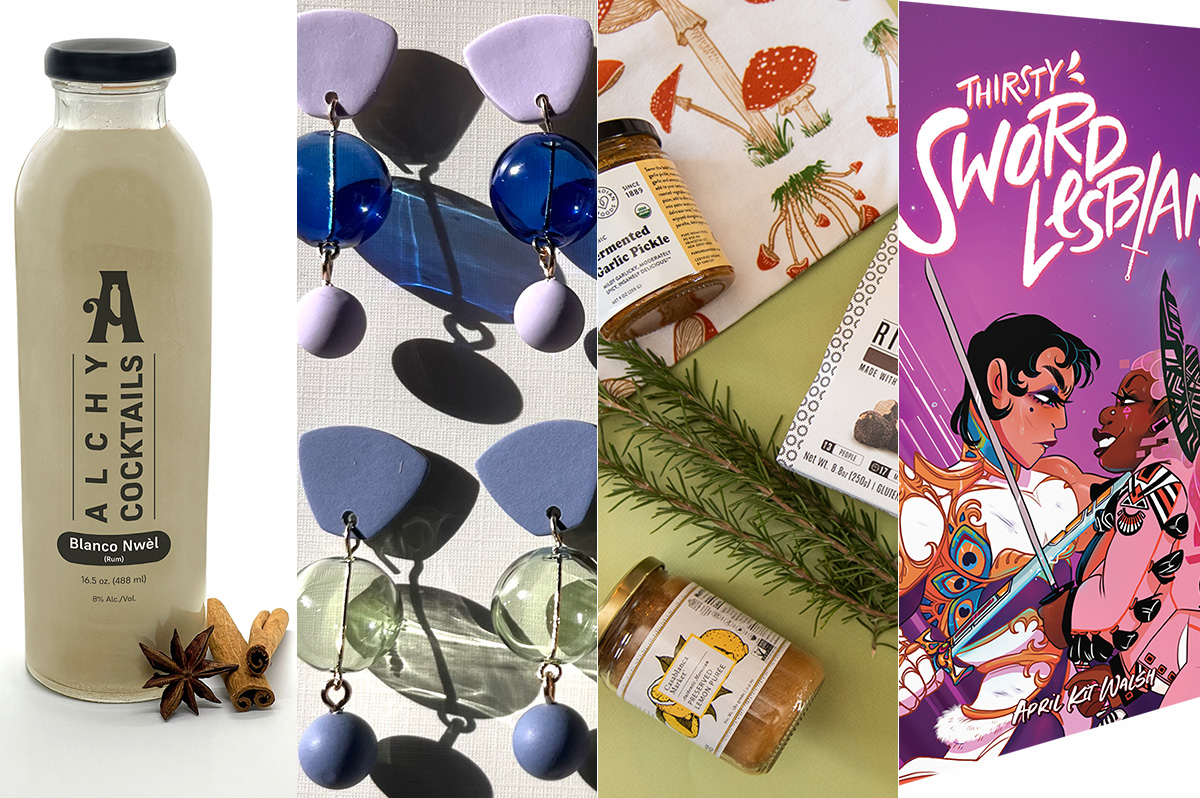
The DowntownDC Holiday Market is bustling. Union Station is decked out with its annual Christmas tree. Washingtonians have wrapped their houses and apartment balconies with festive lights and holiday decorations. The holiday season is here. And with stockings to fill and empty space under the tree, Washington’s local shops and artists have plenty to offer.
Show your LGBTQ and D.C. pride with the Washington Blade’s annual holiday gift guide.
To embrace the holiday buzz: The Blanco Nwèl cocktail from Alchy Cocktails. This Caribbean eggnog is one of Alchy Cocktail’s seasonal holiday cocktails. The flavor profile is similar to coquito, a traditional Puerto Rican Christmas drink with a coconut base. As a queer and Caribbean-owned business, Alchy Cocktails has been based out of Washington since 2021. Blanco Nwèl is available in both cocktail ($24) and mocktail ($12) online and at a variety of holiday markets, including the Tingey Plaza Holiday Market, the Flea Market at Eastern Market, Union Station’s Main Hall Holiday Market, and more. ($24)
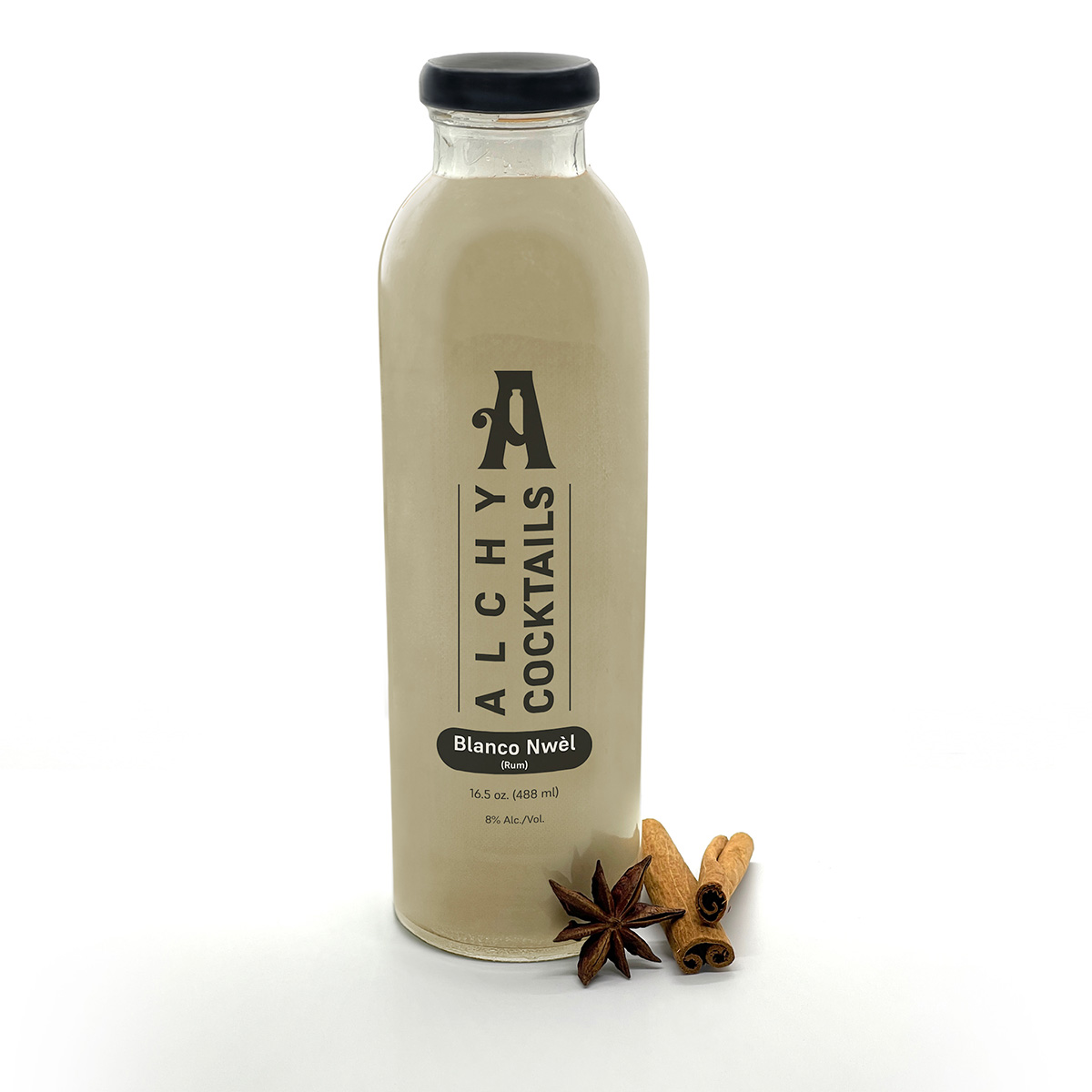
A spicy bite: Gordy’s Cajun Okra from Salt and Sundry. These spicy, tangy pickles pull on Southern Cajun-style flavors, packing a punch with paprika, cayenne, and more. Gordy’s is an LGBTQ-owned and Washington-based brand, making this gift an opportunity to support a local LGBTQ business straight from the jar. This pantry staple is available on Salt & Sundry’s website and at its locations in Union Market, Logan Circle, and its Georgetown holiday pop-up store. ($14)
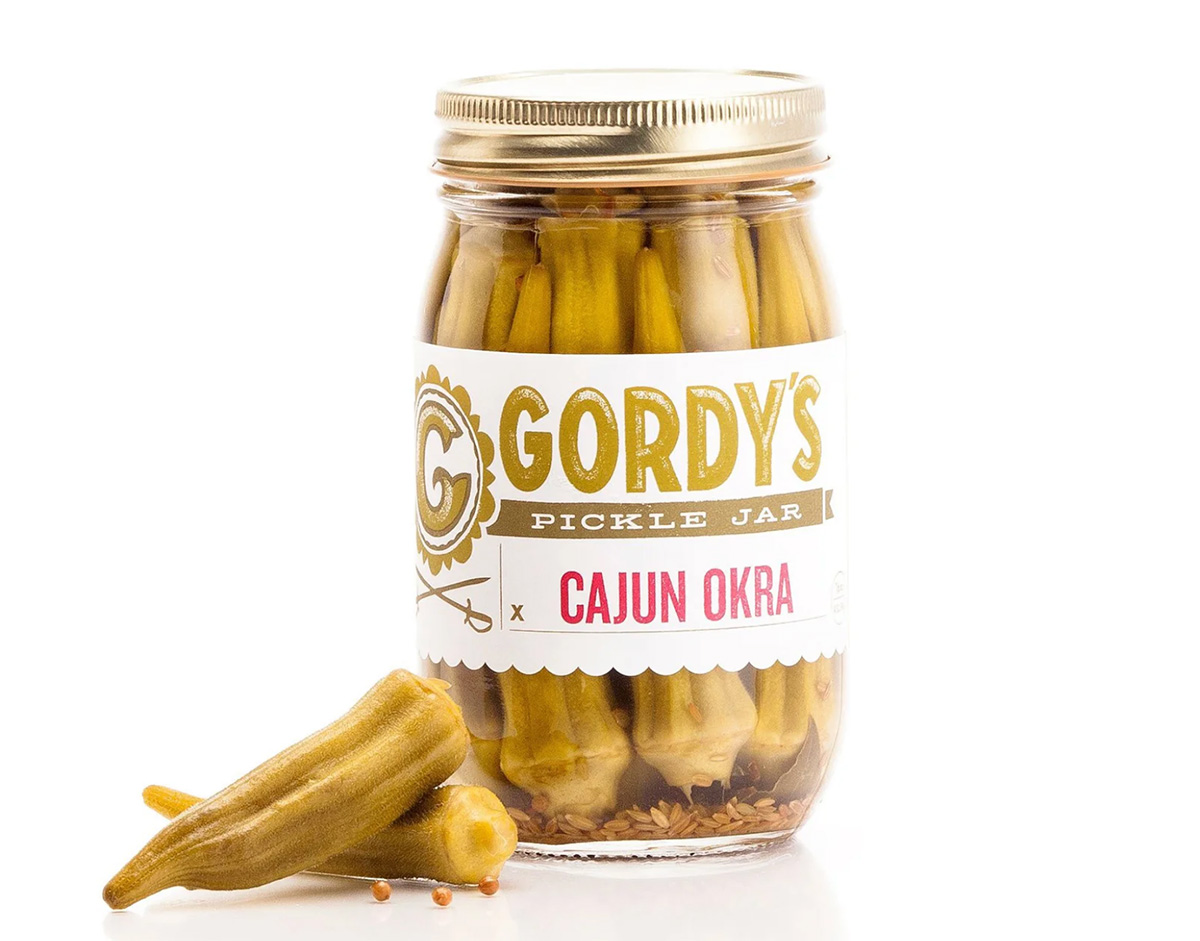
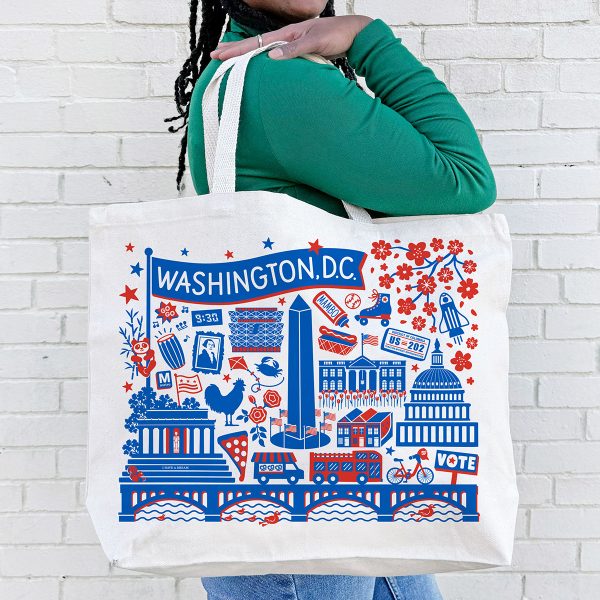
To celebrate Washington pride: The DC Landmark Tote Bag from The Neighborgoods. Native Washingtonians, visitors, friends and family alike will find something to love about this Washington-themed tote bag. Food trucks, the 9:30 Club, the Metro logo and pandas from the National Zoo are just some of the city’s landmarks depicted across the tote in a red, white, and blue color palette. The tote is a part of the DC Landmarks collection, which donates 10 percent of its sales to the American Civil Liberties Union. The Neighborgoods itself is a local, woman-owned business built out of a passion for screen-printing in 2013. The 100 percent cotton canvas tote is for sale online or at the DowntownDC Holiday Market. ($22)
To give friends and family their flowers: The Flowers Bandana from All Very Goods. This 100 percent cotton bandana was designed in Washington and hand printed in India. Its uniqueness comes in being covered with the faces of Black women, representing a “love letter to all women but especially Black women,” according to All Very Goods. The Black woman-owned and operated business, based out of Northwest Washington, has a mission to celebrate diversity and representation through its products. The bandana intends to give Black women their “flowers.” The Flowers bandana is available for purchase online. ($24)
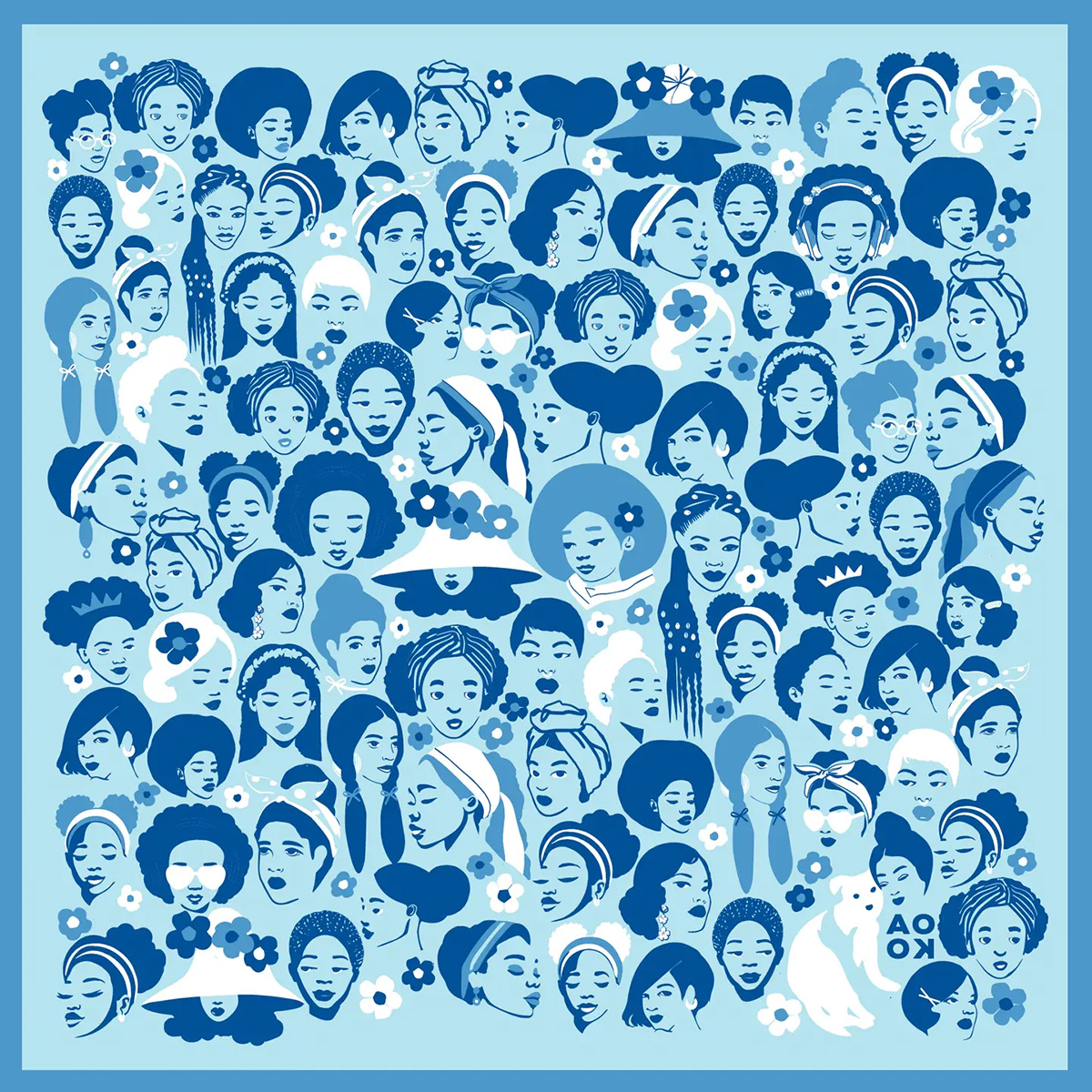
To unlock culinary creativity: The Curious Chef Gift Collection from Each Peach Market. This customizable collection of kitchen oddities — ranging from tinned fish to chili oil — is a quirky gift for the most inventive chefs. The collection is available in a Standard Santa, Extra Goodies and Super Holiday Size for up to $165. The Washington-based market, founded in 2013, permits customers to make the collection special by specifying what unique ingredients are packaged, including products made by local or LGBTQ brands. Each Peach Market offers assembly and pick up in-person at its Mount Pleasant shop and also offers local delivery and nationwide shipping via its website. ($85)
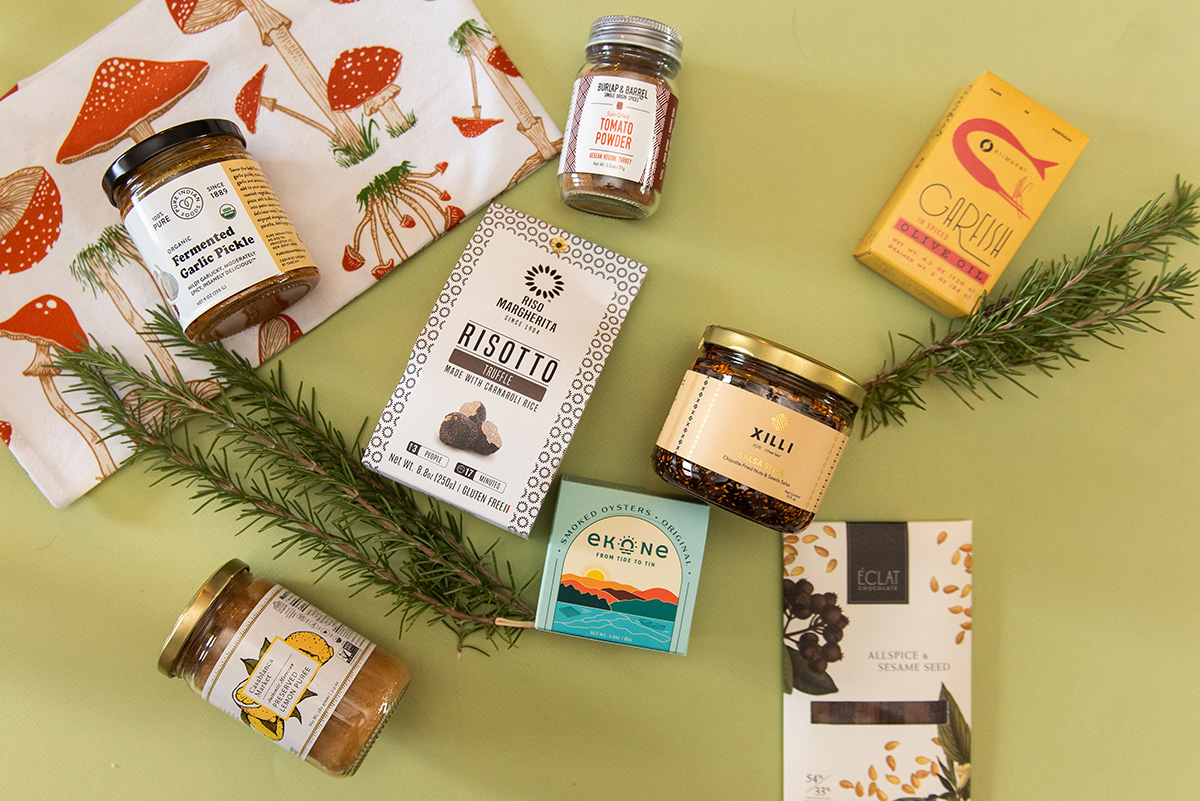
To give a touch of sweetness: The DC Landmark Chocolate Covered Oreo Holiday Cookies from Capital Candy Jar. Wrapped in a festive red bow, this box of nine cookies embraces love for Washington and the holiday season in one. Among the dark and milk chocolate covered cookies are images of the U.S. Capitol, the White House, the Lincoln Memorial, the Jefferson Memorial and festive hollies. The treat, packaged in a Hill East facility just a few blocks from the Capitol, is available for purchase online and at the DowntownDC Holiday Market. ($23.95)
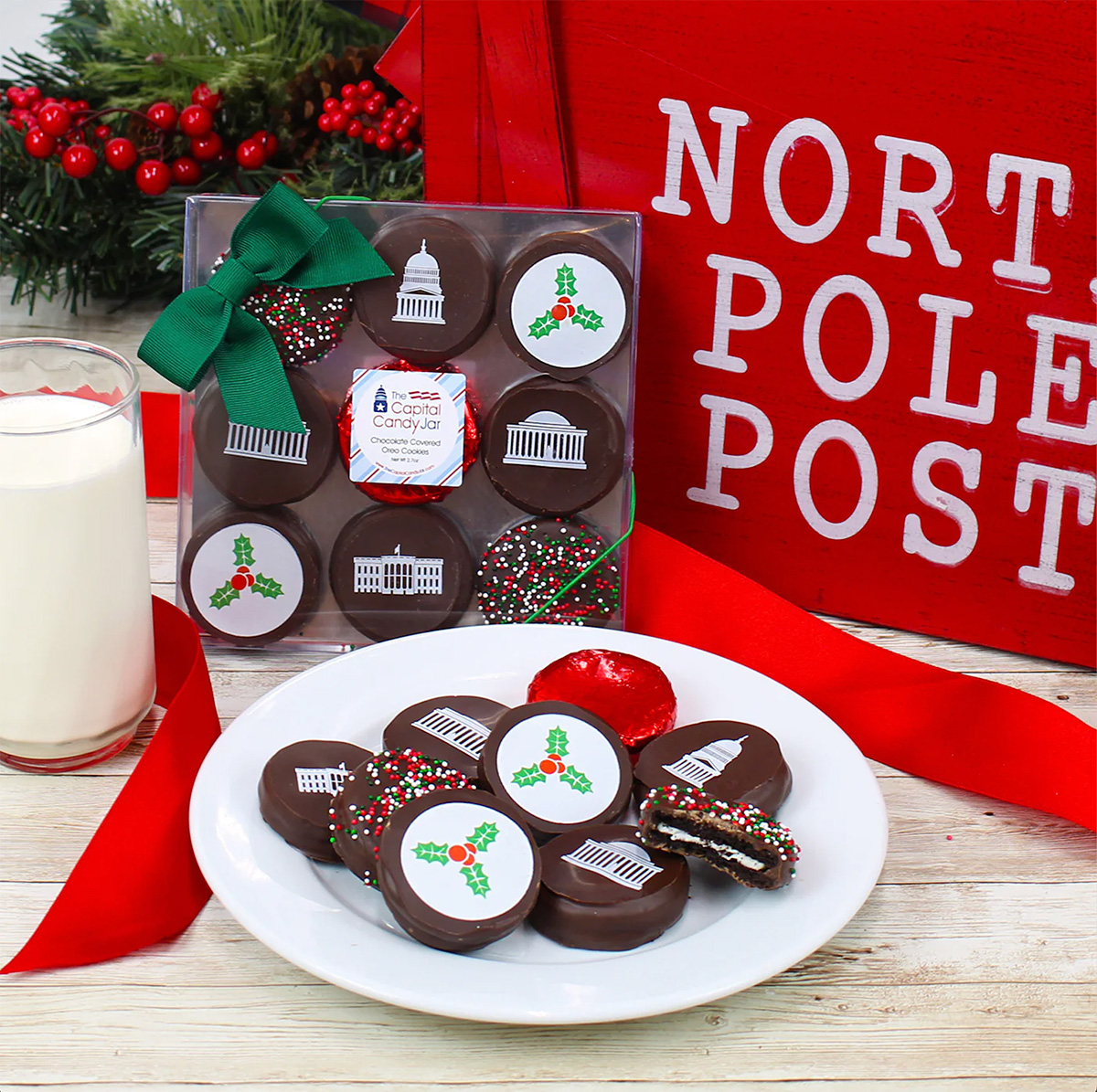
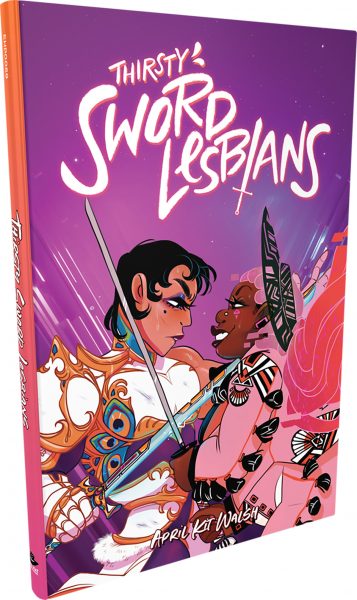
To celebrate queer gaming: Thirsty Sword Lesbians from Labyrinth Games & Puzzles. This roleplaying game embraces lesbian culture by unlocking a world of swords, romance, and battle. Ideal for group settings, the book presents a system of world building and character identities that are best brought to life by creative minds. Labyrinth, which has been a local Washington business for more than 15 years, celebrates non-digital fun through games and puzzles that connect the community. This gift is offered online and at Labyrinth’s Capitol Hill location. ($29.99)
To make a bold statement: The “Resist” T-shirt from Propper Topper. This locally screen-printed black tee features the Washington flag designed within a raised fist, symbolizing both Washington pride, and political resistance. The shirt is made exclusively by Propper Topper, a local Washington business that evolved from a hat shop to a gift store since opening in 1990. The tri-blend unisex shirt is available both for pickup at Propper Topper’s Cathedral Heights location and shipping via the online site. ($32)
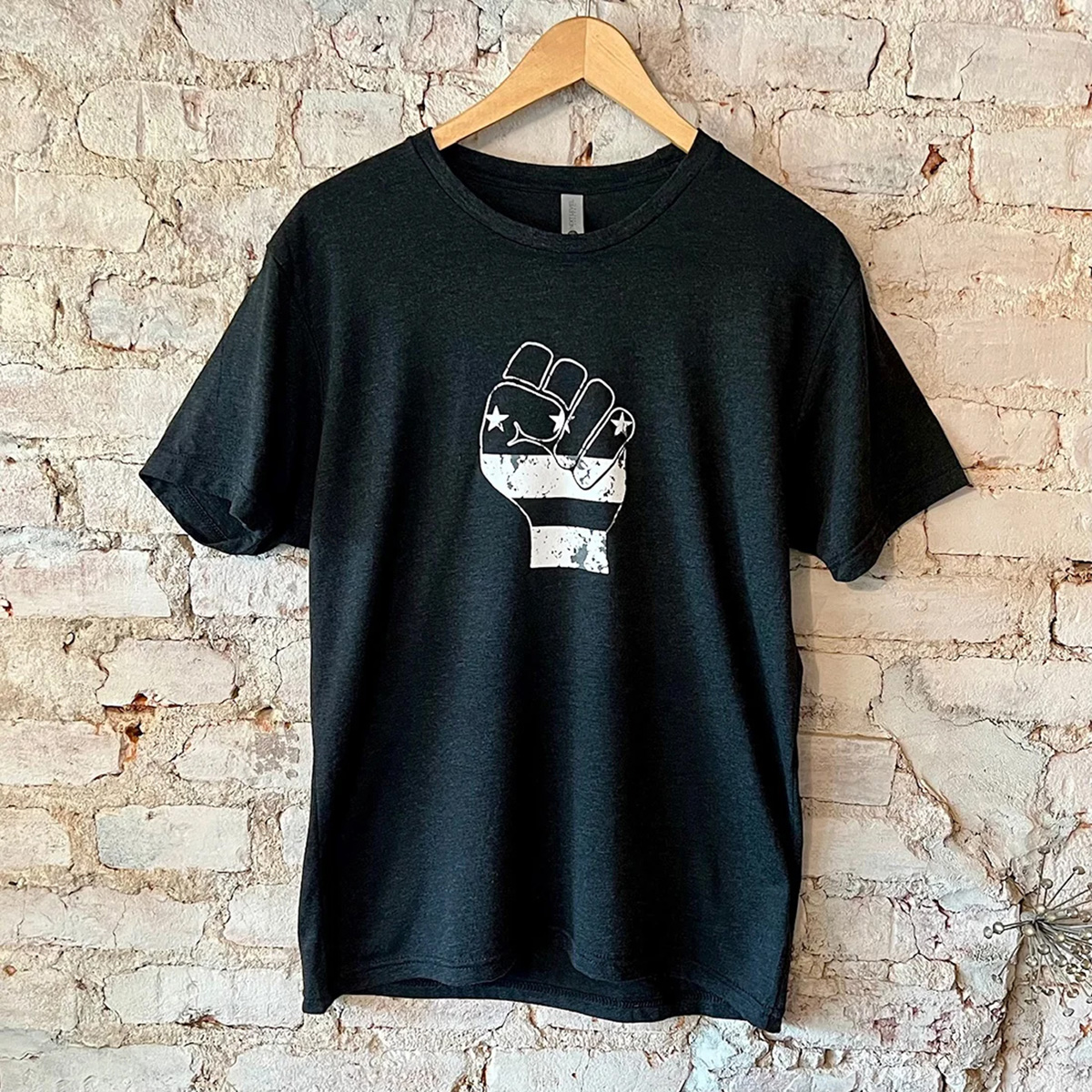
To keep it c(g)lassy: The Glass Ball earrings from Blue Moon Aquarius. Gifting can rarely go wrong when it comes to a new pair of earrings. The unique statement earrings — made of polymer clay, glass, and 18k gold plating over surgical steel — are hand cut, sanded and assembled in Washington, meaning each set is unique. Blue Moon Aquarius, a local brand, is known for its small batch jewelry and home decor designed with clay materials. Available in oxblood, hunter green, lavender, and bluestone color palettes, these earrings are available for purchase on Blue Moon Aquarius’ website and at the DowntownDC Holiday Market. ($48)
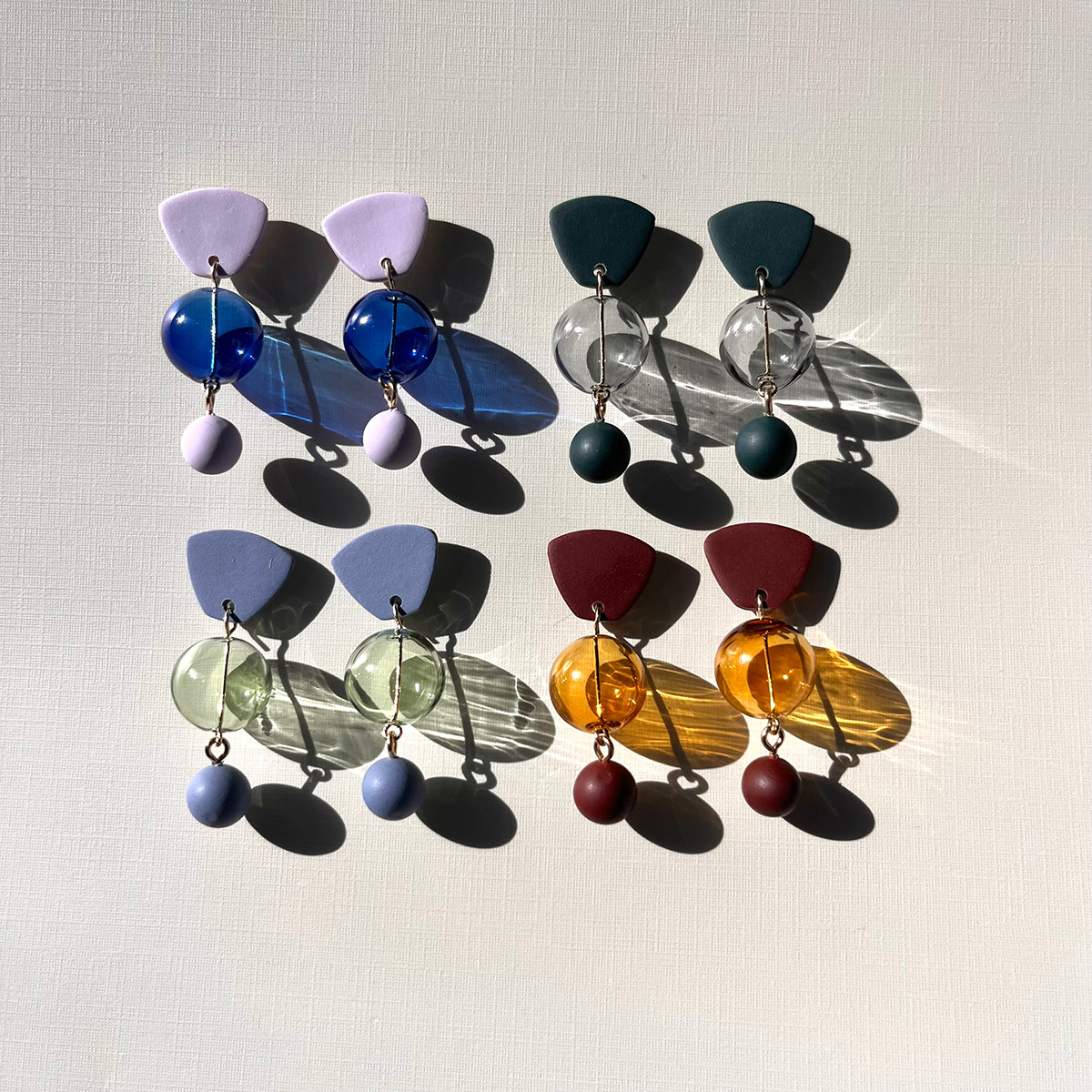
To elevate a holiday tea or charcuterie party: The Honey Flight: Tea Lover’s Selection from BannerBee. This local honey company presents the ideal gift to make cozying up with a cup of tea slightly more special. The Honey Flight contains three types of raw wildflower honey infused with fair trade Ugandan vanilla bean, chai spices, and locally sourced lemon thyme herb. The gift is also an opportunity to uplift a family company based in the Mid-Atlantic that offers all-natural, sustainable products. The flight is available online, at the DowntownDC Holiday Market or at the Arlington Courthouse and Dupont Farmers’ Markets. ($36)
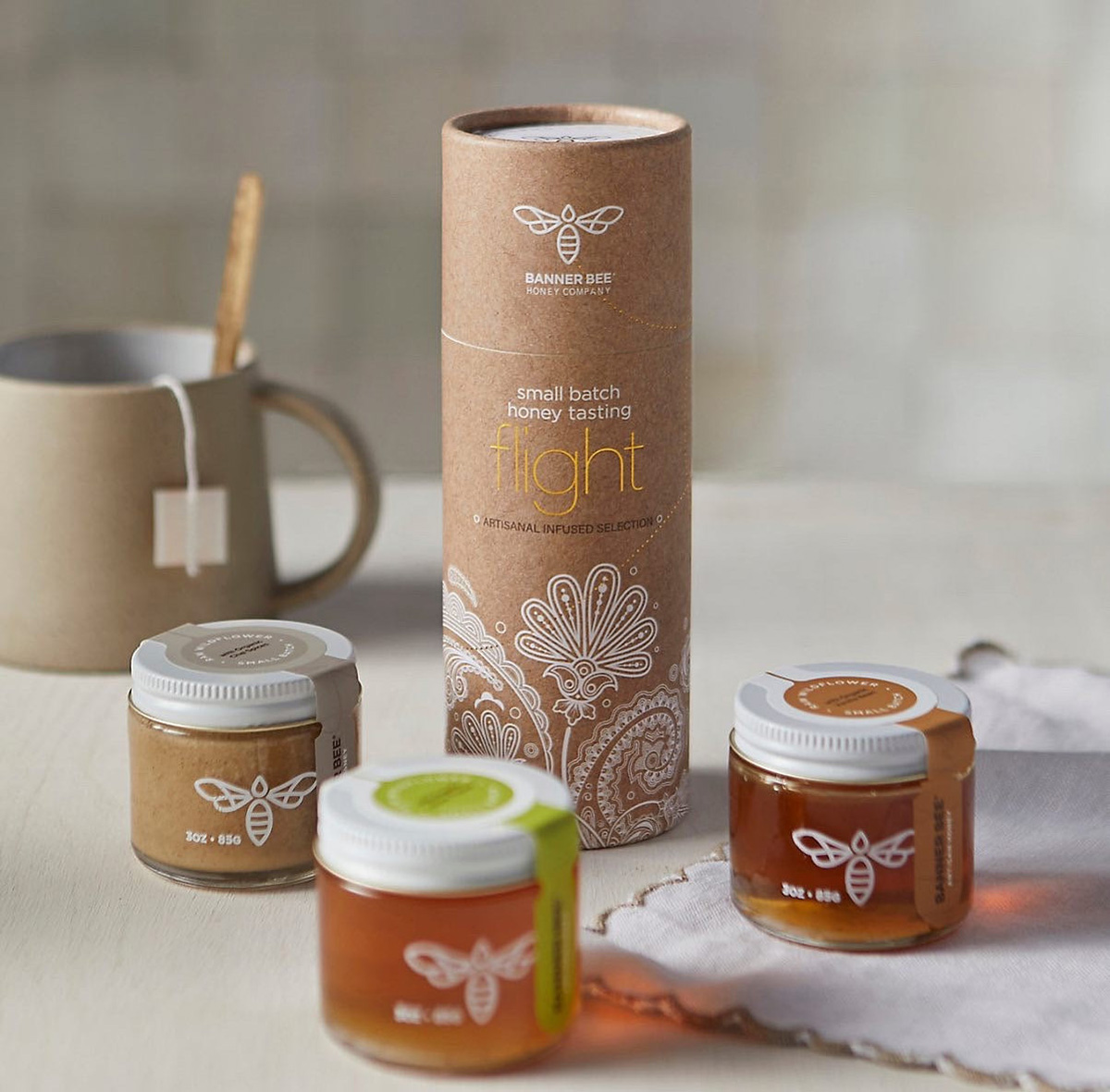
For Baltimore shoppers: If you’re in Charm City, don’t miss Balston Mercantile, opened by a gay couple in June. Their gorgeous shop in the Hampden neighborhood offers an array of unique, upscale finds, from barware and artwork to cookbooks and home decor and more. (849 W. 36th St.)
a&e features
Have yourself a merry John Waters Christmas
Annual holiday show returns to Alexandria and Baltimore
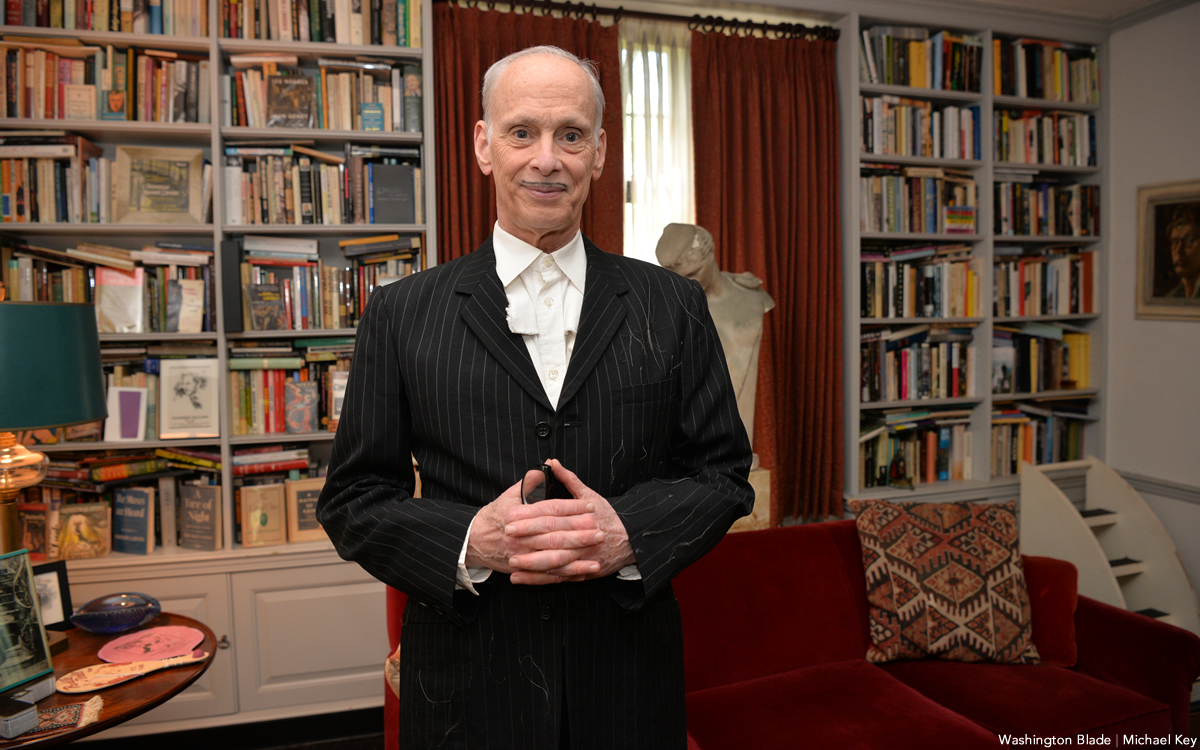
When it comes to iconic Christmas scenes in movies, none can top the tree-toppling tantrum thrown by cha-cha heels-deprived Dawn Davenport in John Waters’s fifth full-length feature “Female Trouble” from 1974. Therefore, it’s not surprising that Waters continues to make art out of Christmas, performing his spoken word Christmas tour in cities across the country. Waters has even more reason to celebrate with the release of his new red vinyl 7” single, a cover of Little Cindy’s “Happy Birthday Jesus (A Child’s Prayer)” on the A-side, and “A Pig Latin Visit From St. Nicholas” on the B-side. If you’re still looking for unique Christmas gifts, consider this record. As always, John was kind enough to make time for an interview in advance of his tour dates.
BLADE: John, in preparation for this interview with you, I went back and listened to Little Cindy’s original rendition of “Happy Birthday Jesus (A Child’s Prayer)” on your “A John Waters Christmas” CD.
JOHN WATERS: One thing I did, if you notice, I make the same stumble in my recording that she did in the original.
BLADE: It sounded to me like she got choked up.
WATERS: No, I think she just stumbles over a word, so I stumbled over the same word. It’s appropriation, insanely.
BLADE: Is this a song you first became aware of in your youth or when you were an adult?
WATERS: When I was doing the Christmas album, I had this friend named Larry Benicewicz. He was kind of my idea man with music. He knew every single old record. I would say to him, “Weird Christmas songs,” when we were doing a soundtrack, or a song about bears, or a song about this, and he would give me all these tapes. It was one of the ones he played for me. A lot of the songs I put in my movies and on my records, I did know as a kid. I did not know this one, but I immediately embraced it. I don’t think it’s campy. I think it really is spiritual in a weird way. My doing it makes it a novelty record. I am really for novelty records, and there aren’t any anymore. Why was there not a COVID novelty record? That’s insane. The dance “The Bug” that’s on the “Hairspray” soundtrack would be perfect for COVID.
BLADE: The thing that struck me was that for a Christmas song in the voice of a child, a kind of death pall hangs over it, with lines like, “If I was good you’d let me live with you” and “they nailed you to the cross, they wanted you to die.”
WATERS: All of it! When I see children at midnight mass kneeling in front of a nude man nailed to a cross, I feel like I’m at The Eagle! It is S&M, it’s creepy. I took the same cover (photo) from her record to parody and put my face on it. The same thing I did with The Singing Dogs last year when I covered (their version of) “Jingle Bells.” I’m really into novelty records. I love them and I’m trying to bring them back. I don’t expect anybody to ever play these records. Even The Singing Dogs one said on it, “Please do not play this record” [laughs]. And the flipside, the Pig Latin version, is almost impossible to listen to.
BLADE: I’m so glad you mentioned that. “A Pig Latin Visit From St. Nicholas” reminded me of the lost art of speaking in Pig Latin. I also recall watching the PBS series “Zoom” as an adolescent and learning to speak “ubbi dubbi,” a distant relative of Pig Latin. Do you think that the time is right for a Pig Latin or ubbi dubbi revival?
WATERS: Here’s the thing, I never could pick up any language, except Pig Latin. I’ve been in every foreign country. Foreign countries have given me money to learn to speak the language. I can never do it! But Pig Latin…my parents and other parents in the ‘50s spoke Pig Latin so kids couldn’t understand what they were saying. Then my mother taught it to me, and I used it. The hardest take to shoot in “Pink Flamingos” was not eating the dog shit. It was when the cast skipped, in one take, saying “E-way, are-yay e-they ilthiest-fay eople-pay in-hay e-they ole-hay ide-way orld-way.” We’re the filthiest people in the whole wide world in Pig Latin. We had to do so many takes so they could do it once without screwing it up. In “Polyester,” Edith (Massey) answers the phone, “ello-hay.” I did a photo piece where it was all subtitled in Pig Latin. Like “osebud-Ray” (from “Citizen Kane”) or in “Streetcar,” “ella-Stay!” [Laughs] All the iconic dialogue translated into Pig Latin. My assistant who helped me do it, had never heard of Pig Latin. She really got good at it because she lived in many foreign countries and can pick up languages. But it’s not that easy to do it correctly and read it. Your computer will translate into Pig Latin.
BLADE: AI understands Pig Latin?
WATERS: I guess that’s AI. It wasn’t 100% right, but it was close. I can speak it if I look at it, but just do a bit at a time. It was a challenge that no one would possibly care about or want to do.
BLADE: I think you pulled it off very well.
WATERS: If you want people to leave on Christmas morning, you put it on. That’s how you get your guests to leave. It’s time to go.
BLADE: Ood-gay i-bay! How did your relationship with record label Sub Pop, which released 2021, 2022, 2024, and new 2025 holiday singles, come about?
WATERS: I believe the first thing I did for them was “Prayer to Pasolini.” They came to me through Ian Brennan. He’s won a couple Grammys for World Music, but he is also is one of my agents who does the Christmas tour and a lot of my shows, anything with music. He helped me arrange each one of the songs. He had a relationship with Sub Pop. It was perfect. My friends in Baltimore, (the band) Beach House, have had huge success.
BLADE: That’s right, they’re on Sub Pop!
WATERS: Yes! I’m happy to be on it. I’ve even been to the warehouse and posed for pictures like Jackie Suzanne used to do.
BLADE: Is there any chance that “A John Waters Christmas” might be reissued on vinyl by Sub Pop?
WATERS: No. It’s such a nightmare to get the rights and to renew them. You have to find the publisher and the writer, and they usually hate each other. It doesn’t matter if it’s obscure or famous, it’s hard to get. You have to make the deal. The singer doesn’t get anything unless they play it on the radio. It would be so complicated legally, and there would be such a [laughs] tiny audience for it. I hope it will come out again. The same thing with the one for Valentine’s Day. I had two of them that did quite well when they came out; “A Date With John Waters and “A John Waters Christmas.” The “John Waters Christmas” album is still the soundtrack that plays whenever I’m doing my spoken word Christmas show as people are entering the theater.
BLADE: Aside from your annual Christmas show tour, what else do you do for the holidays now, and are there any traditions that you’ve carried over from your family?
WATERS: Certainly! I have two sisters, my brother’s widow, and me, so there are four and we take turns each year to have the Christmas dinner. Mine was last year. An entire sit-down dinner. Mom’s China, the silverware, the entire full dinner. It’s pretty traditional. I don’t have a Christmas tree, but I do decorate the electric chair from “Female Trouble.” That is a tradition in my family. We do have Christmas decorations, but they’re usually weird ones that fans sent me. I have one with Divine knocking over the Christmas tree, and the Christmas tree lights up, all sorts of amazing things. There is definitely a tradition here that might be a little altered, but it is definitely a tradition. I used to have a giant party every year, but COVID ended that. I still wouldn’t want 200 people in my house breathing right now.
BLADE: I was looking at your tour schedule and wondered if there are any new cities in which you’ve never performed the John Waters Christmas show that have been added to this year’s schedule?
WATERS: I don’t think there’s a city in America in which I haven’t done one show! The only places I haven’t been to are Hawaii and Alaska. I could do it there, but it’s too long on a tour. I can’t think of a city I haven’t played in in America over the last 50 years. The Christmas show is completely different every year. It doesn’t matter if you saw it last year.
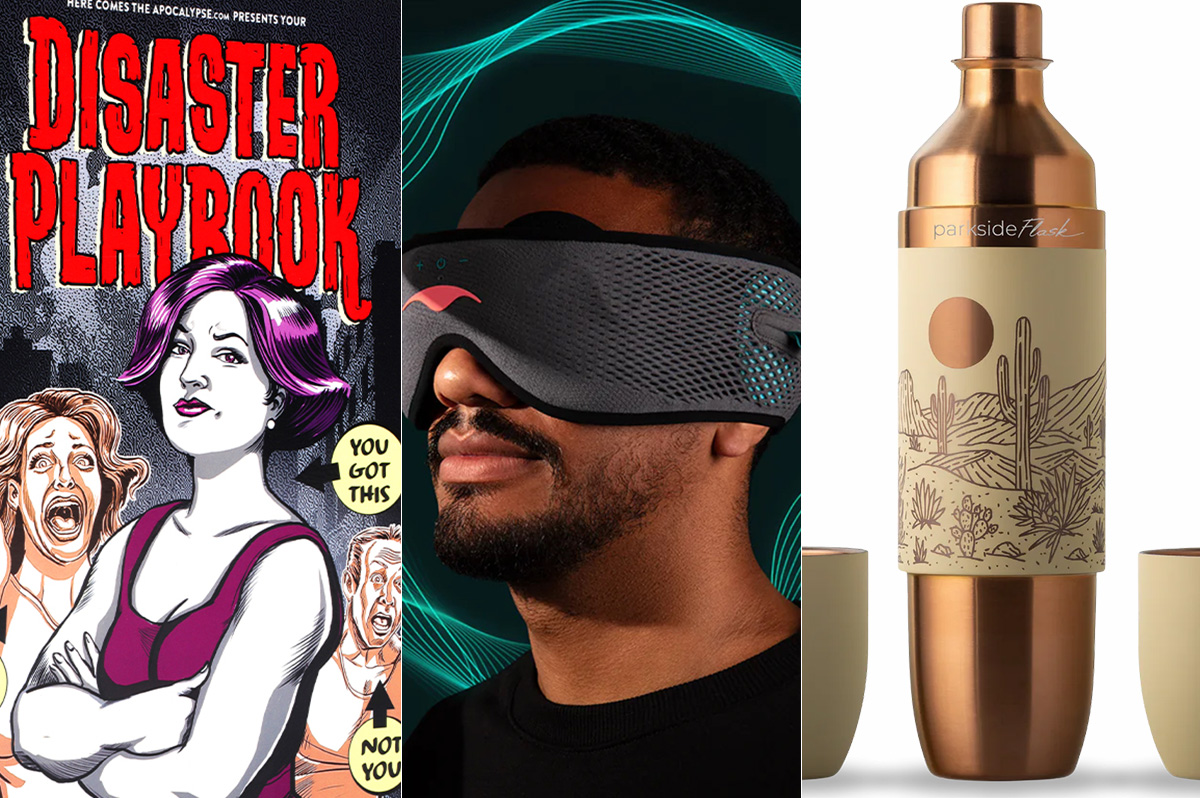
Some gifts scream practical, others whisper luxury, and a few flat-out blur the lines. From cocoa that feels ceremonial to a cologne that linger like a suggestive smirk, this year’s ultimate gift picks prove that thoughtful (and occasionally naughty) presents don’t have to be prosaic. Welcome to your holiday cheat sheet for festive tangibles that get noticed, remembered, and maybe even result in a peck of gratitude planted under the mistletoe. Consensually, of course.
Amber Glass Champagne Flutes
Pop the champs – but make it vintage. These tulip-shaped stunners in amber-tinted glass bring all the Gatsby vibes without the Jazz-age drama. Whether you’re toasting a milestone or celebrating a Tuesday, their seven-ounce capacities and hand-wash-only care make ‘em as practical as they are pretty. Pair with a thoughtful bottle of bubs and gift with a glittering wink. $18, NantucketLooms.com
Disaster Playbook by Here Comes the Apocalypse
Because the end of the world shouldn’t be a solo act, this spiral-bound guide is your step-by-step roadmap to surviving and thriving when everything else goes sideways, which might be sooner than you think. Packed with checklists, drills, and a healthy dose of humor, it’s like a survival manual written by your most prepared (and slightly snarky) friend. Whether you’re prepping for a zombie apocalypse or, more realistically, REVOLUTION!, this playbook’s got your back. $40, HereComesTheApocalypse.com
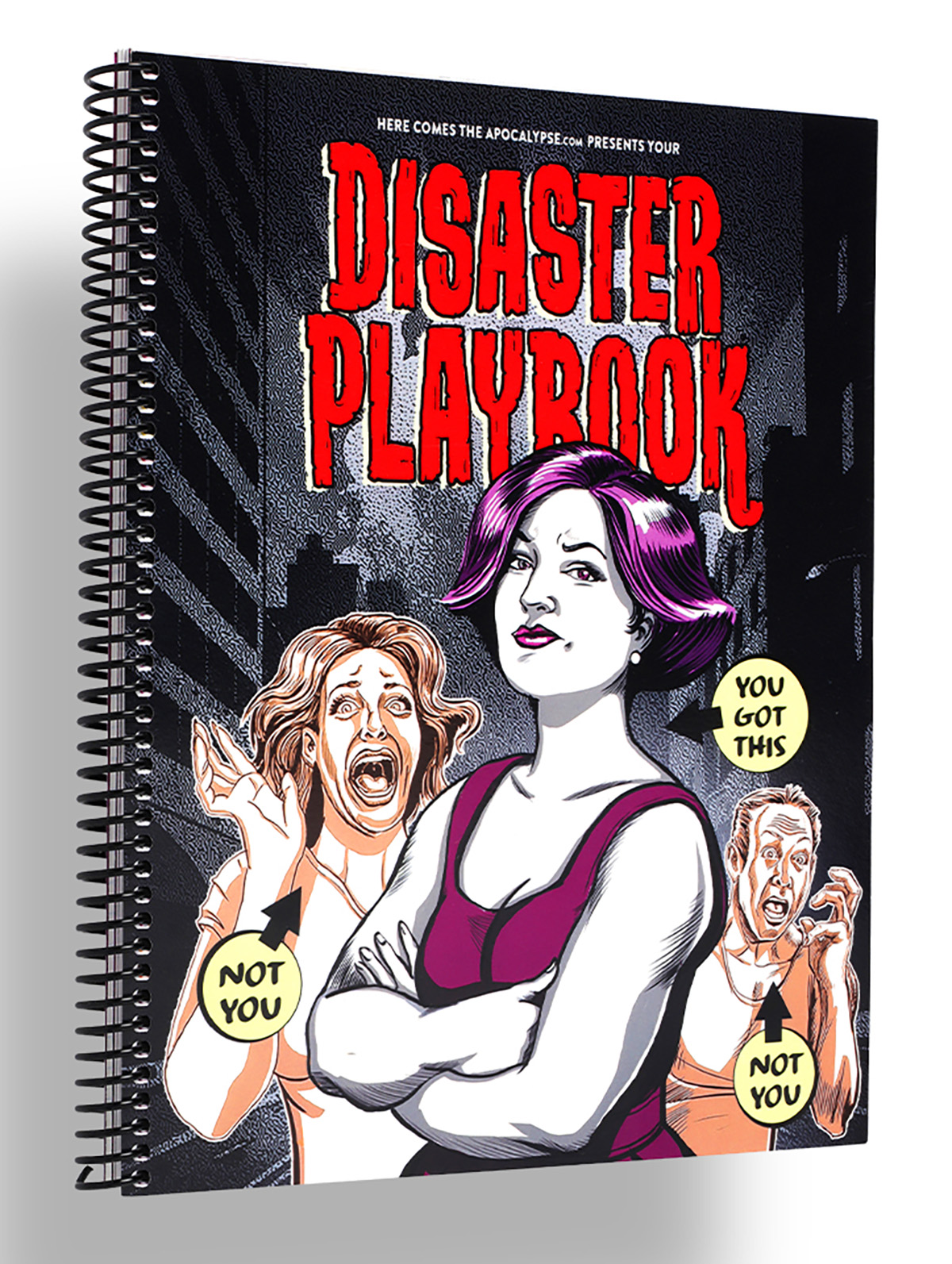
Wickless Vulva Candles
Bold, luxurious, and completely flame-free, CTOAN’s wickless candles melt from beneath on a warmer, releasing subtle, sophisticated fragrances, like sandalwood or lavender. The vulva-shaped wax adds a playful, provocative element to any space –perfect for a bedroom, living room, or anywhere you want elegance with an edge. A gift that celebrates form, intimacy and self-expression, no fire required. $39, CTOANCO.com
Villeroy & Boch Royal Classic Christmas Collection
Every meal is a mini celebration – with whimsy at every place setting – in Villeroy & Boch’s Royal Classic festive dinnerware collection that hits all the right notes. Made from premium German porcelain, it features nostalgic little toys, nutcrackers, and rocking horses in delicate relief, giving your holiday spread a playful but refined twist. Dishwasher- and microwave-safe, it’s luxe without the fuss. Gift a piece to a special someone, or start a collection they’ll use (and show off) for years to come. $22-$363, Villeroy-Boch.com
Greenworks Electric Lawnmower
You a ’hood queen who considers lawn care performance art – or just wants to rule the cul-de-sac in quiet, emission-free glory? Greenworks’ zero-turn electric mower has the muscle of a 24-horsepower gas engine but none of the fumes, drama or maintenance. Six 60V batteries and a 42-inch deck mean you can mow up to two-and-a-half acres on a single charge – then plug in, recharge, and ride again. It’s whisper-quiet, slope-ready, and smooth enough to make you wonder why you ever pushed anything besides your queer agenda. The perfect gift for the homeowner who loves sustainability, symmetry, and showing off their freshly striped yard like that fresh fade you get on Fridays. $5,000, GreenworksTools.com
Molekule Air Purifier
For the friend who treats their space like a sanctuary (or just can’t stand sneezes), the Molekule Air Pro is magic in motion. Covering up to 1,000 square feet, it doesn’t just capture allergens, VOCs, and smoke – it destroys them, leaving your air feeling luxury-clean. FDA-cleared as a Class II medical device, it’s serious science disguised as modern design. Gift it to your city-dwelling, pet-loving, candle-burning friend who likes their living room as pristine as their Instagram feed. $1,015, Molekule.com
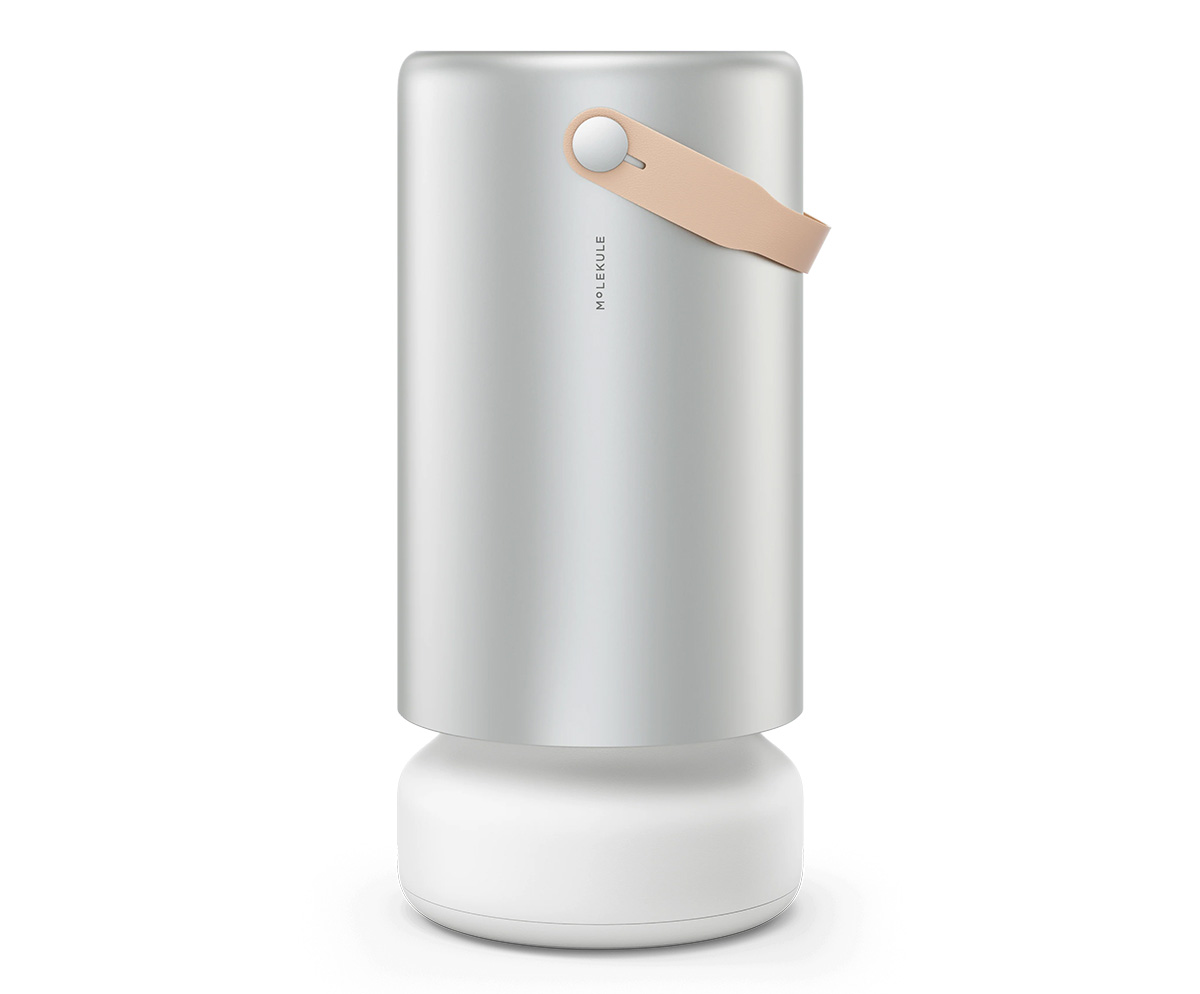
Cipriani Prosecco Gift Set
Effervescent with stone-fruit sweetness and a touch of Italian flair, the Cipriani Bellini & Prosecco gift set brings brunch-level glamour to any day of the week. The Bellini blends rich white-peach purée with sparkling wine, while the dry ’secco keeps things crisp and celebratory. Pop a bottle, pour a flute, and suddenly winter weeknights feel like a party – even with your pants off. $36, TotalWine.com
Woo(e)d Cologne
British GQ recently crowned Woo(e)d by ALTAIA the “Best Date Night Fragrance,” and honestly, they nailed it. Confident without being cocky – smoky gaïac and Atlas cedarwood grounds the room while supple leather and spicy cardamom do all the flirting – it’s a scent that lingers like good conversation and soft candlelight. Gift it to the one who always turns heads – or keep it for yourself and let them come to (and then on) you. $255, BeautyHabit.com
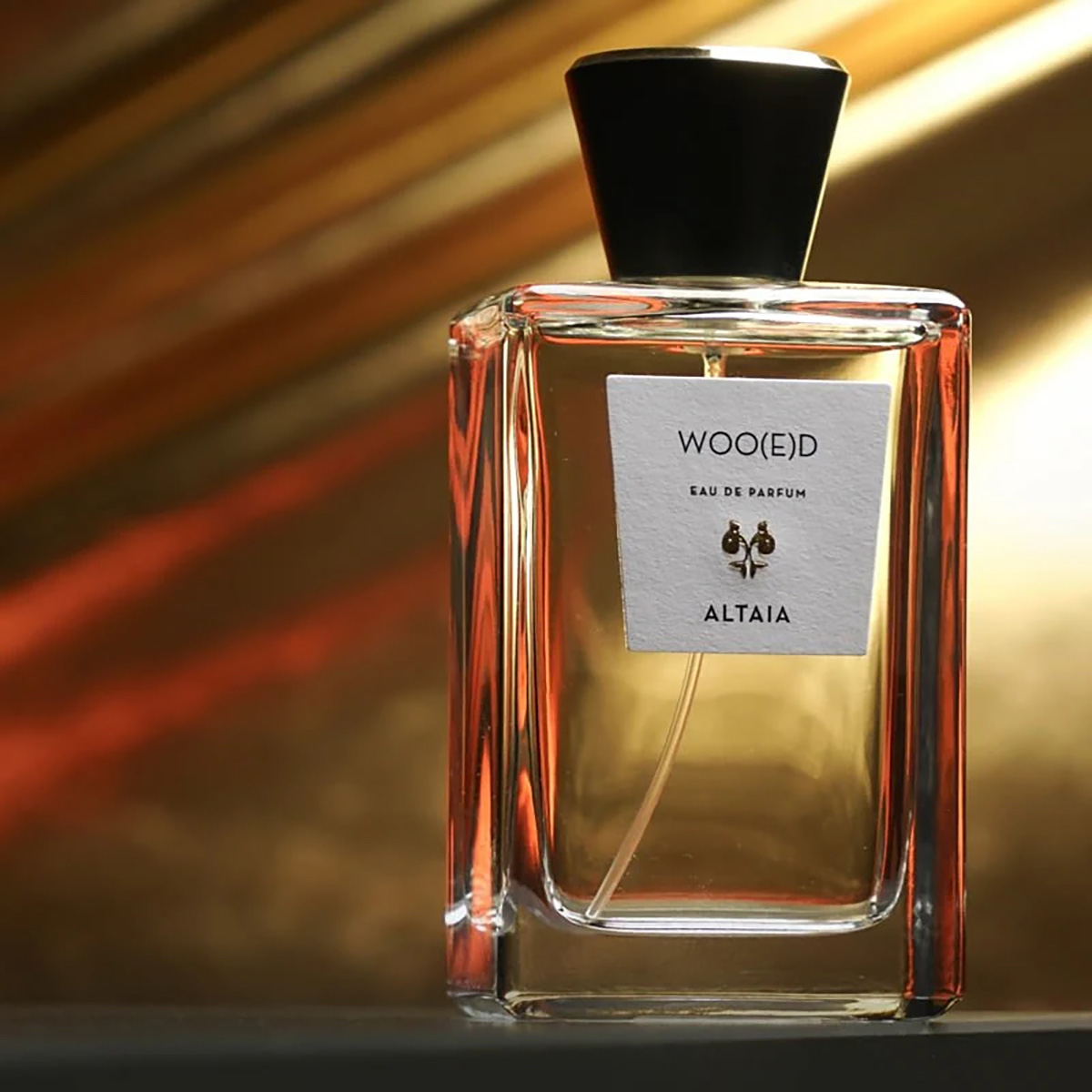
Lococo Cocoa Kit
Keep the run-of-the-mill mugs in the cabinet this Christmas and pull out Lococo’s handcrafted Oaxacan versions that demand you slow down and sip like it matters. Paired with a wooden scoop, rechargeable frother, and Lococo’s signature spice hot-chocolate blend (vegan, gluten-free, with adaptogenic mushrooms), this holiday kit turns Mexi-cocoa into a mini ritual you’ll look forward to. Perfect for anyone who loves a little indulgence with a side of ¡A huevo! energy.
Manta Sleep Mask
Total blackout, zero pressure on the eyes, and Bluetooth speakers built right into the straps, this ain’t your mama’s sleep mask — but it could be. The Manta SOUND sleep mask features C-shaped eye cups that block every hint of light while ultra-thin speakers deliver your favorite white noise, meditation, or late-night playlist straight to your ears. With 24-hour battery life, breathable fabric, and easy-to-adjust sound, it turns any bed (or airplane seat) into a five-star sleep suite. Perfect for anyone who treats shut-eye like an art form (or just wants to escape their roommate’s late-night bingin’ and/or bangin’). $159, MantaSleep.com

Shacklelock Necklace
Turn the industrial-chic vibe of a shackle into a sleek statement. Mi Tesoro’s platinum-plated stainless-steel necklace sits on an 18-inch wheat chain, featuring a shackle-style latch pendant that’s waterproof, tarnish-free, and totally fuss-les. Beyond style, it nods to a classic gesture in the queer leather community: replacing a traditional Master lock with something elegant to quietly signal belonging to someone special. Wear it solo for a minimalist edge or layer it like you mean it; either way this piece locks in both your look and your intentions. $90, MiTesoroJewelry.com
Parkside Flask Mojave Edition
Wine nights get a desert glow-up with Parkside’s limited-edition 750-milliliter all-in-one flask draped in sun-washed bronze and badland hues like sage, sand, and terracotta – with magnetic stemless tumblers that snap on for effortless shareability. It keeps your vino chilled for 24 hours, pours without drips (no tears for spilled rosé, please), and even lets you laser-engrave your own mantra or inside joke. Perfect for picnics, surprise rooftop clinks, or gifting to your favorite wine (or desert) rat. $149, HighCampFlasks.com
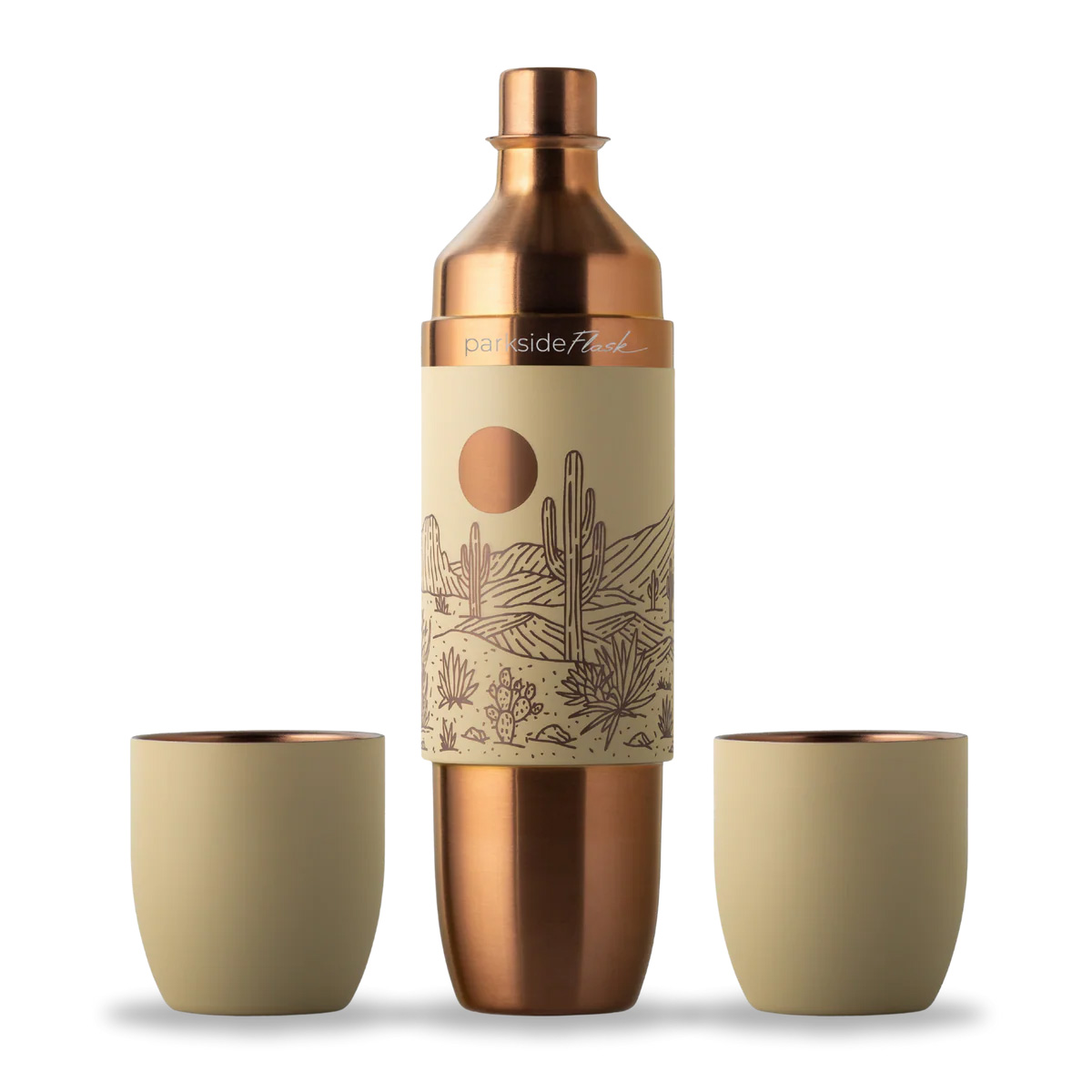
Mikey Rox is an award-winning journalist and LGBT lifestyle expert whose work has published in more than 100 outlets across the world. Connect with him on Instagram @mikeyroxtravels.

